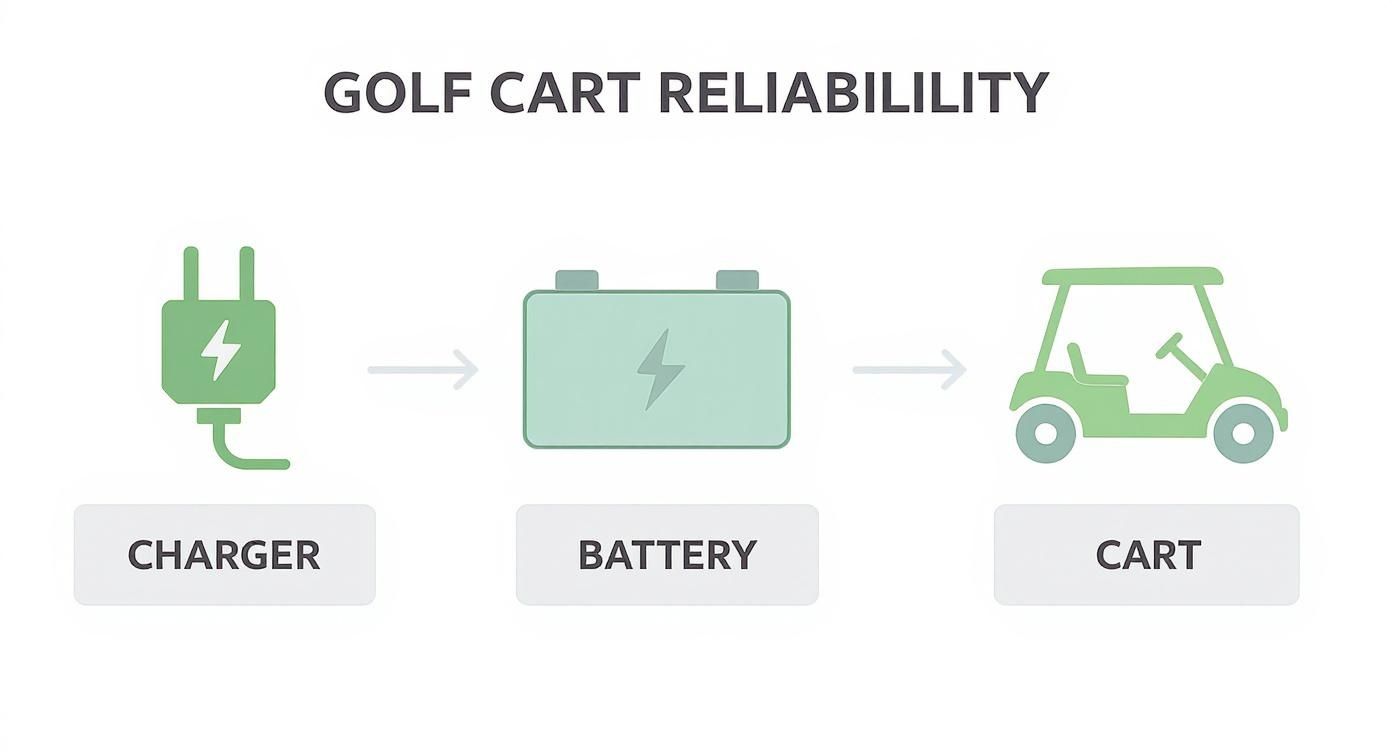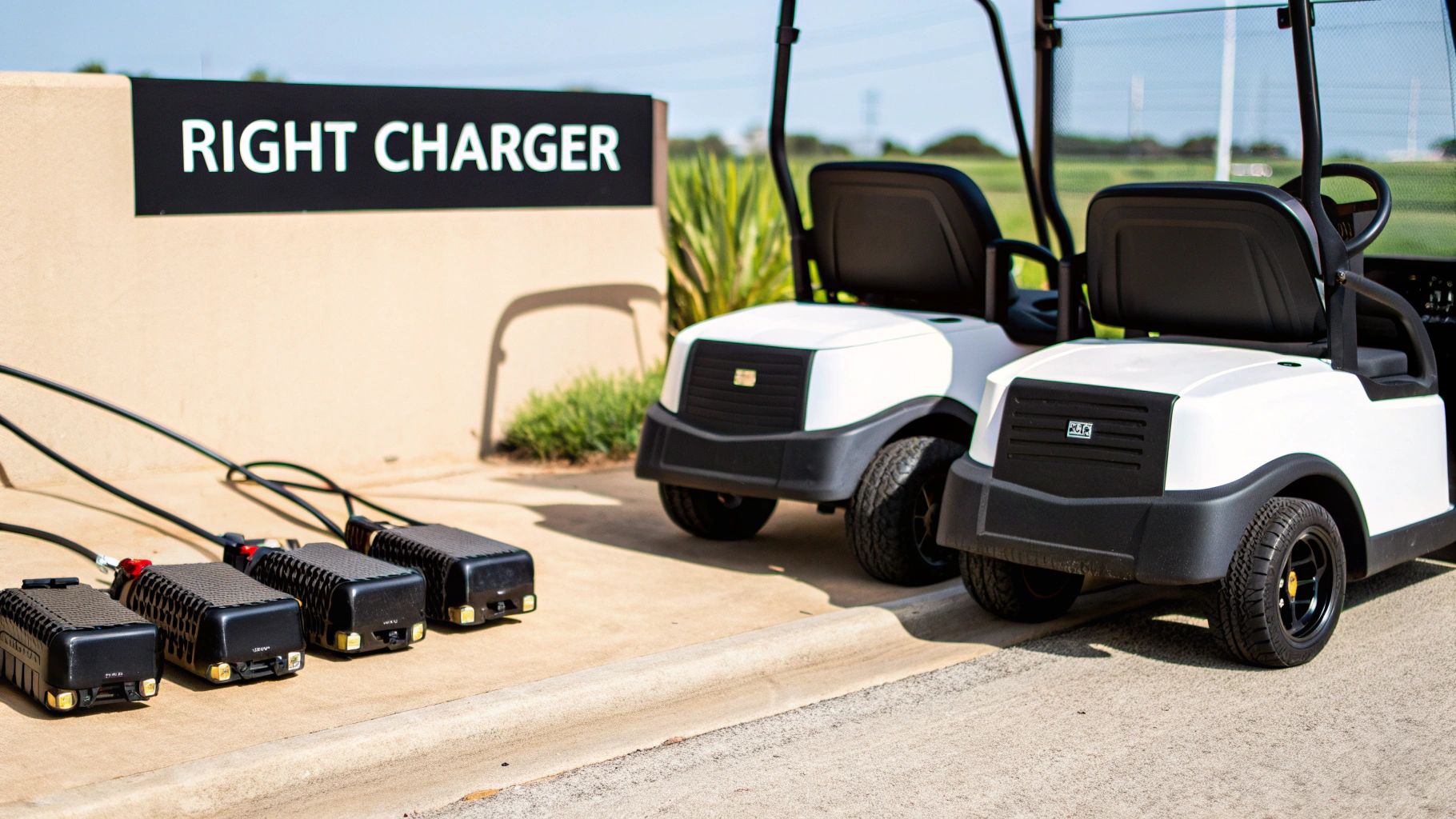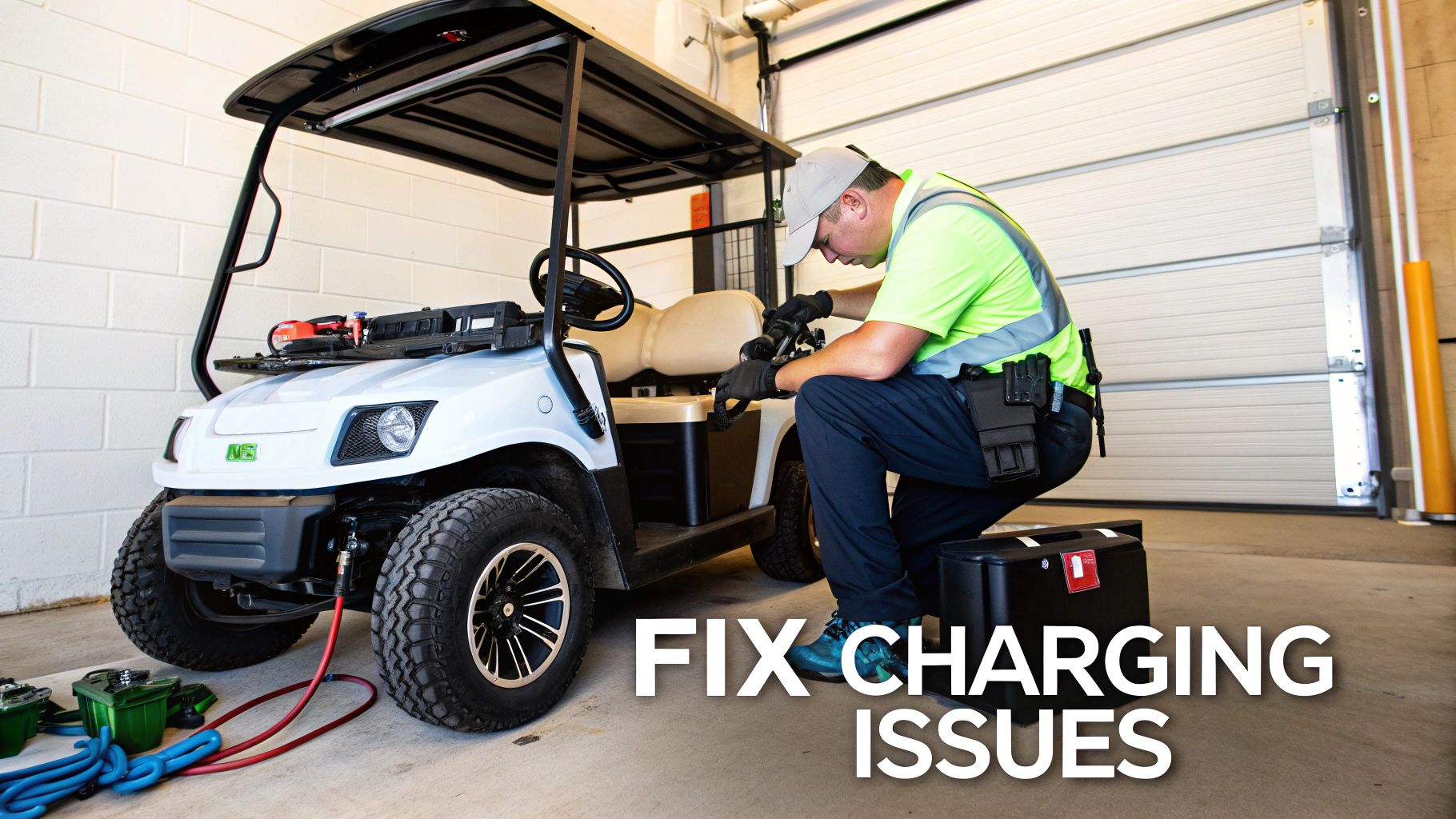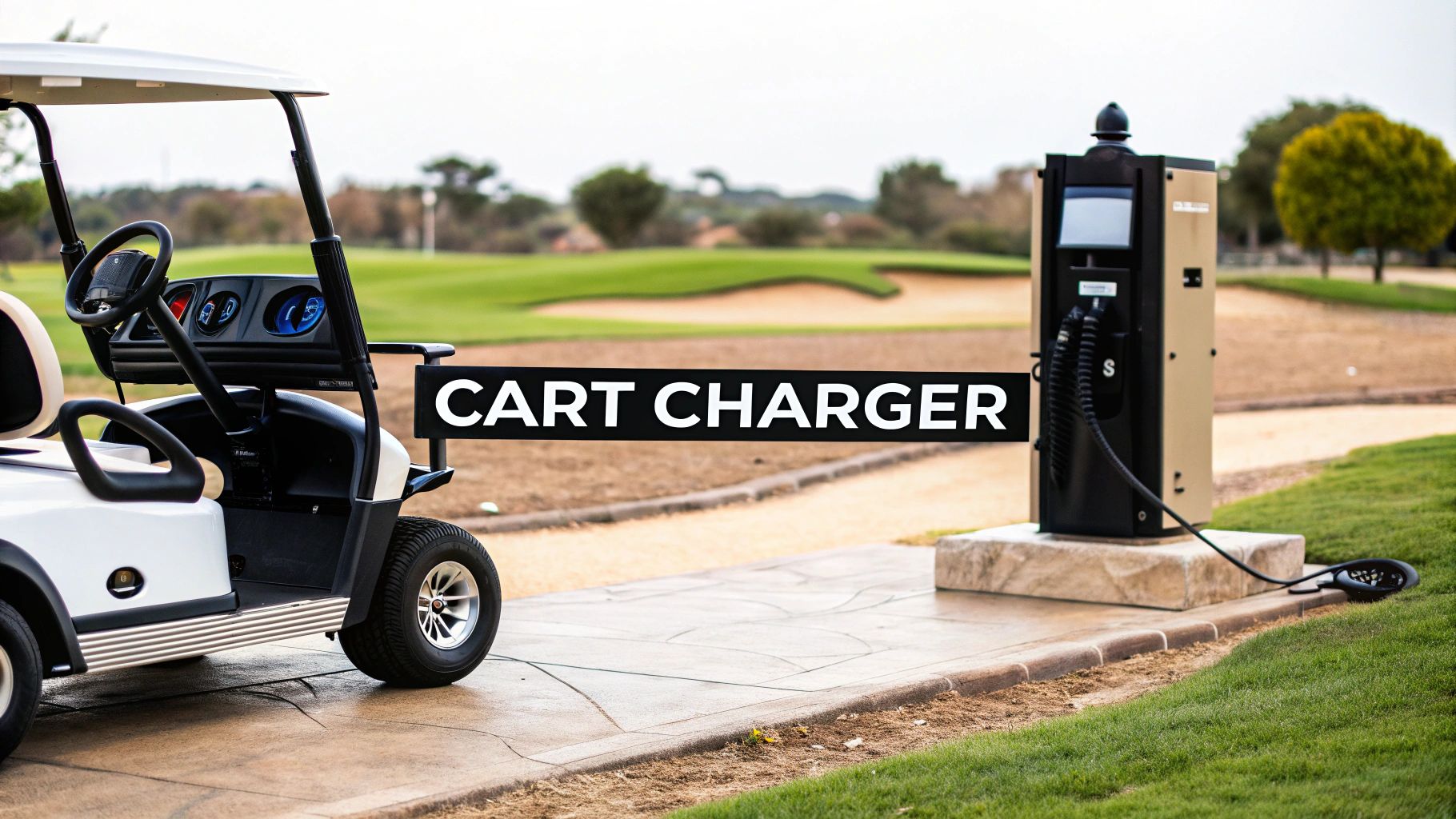There's nothing worse than having a perfect day on the course cut short by a dead golf cart. That frustrating walk back to the clubhouse highlights a simple truth: your golf cart is only as good as its charger, the lifeline that keeps you moving from the first tee to the eighteenth green.
Keeping Your Golf Cart Ready for the Green
A dependable charger is more than just a power cord; it's the guardian of your biggest investment. Your cart's batteries are its most expensive and critical component, and how you charge them directly impacts their lifespan and performance. Getting this right means fewer surprises on the course, lower maintenance costs down the road, and more time enjoying the game.
This guide is your complete playbook for everything you need to know about your golf cart charger. We'll go beyond the basics to give you a real, practical understanding of how these devices work and the essential habits that will protect your batteries for years to come. This is more important than ever, as electric carts continue to take over the market. In fact, with the North American golf cart market projected to hit USD 1.13 billion by 2033, the shift to electric power is undeniable.
Think of this as your roadmap to avoiding common charging mistakes and ensuring your cart is always ready for peak performance. We will cover:
- The science behind how chargers bring your batteries back to life.
- How to pick the perfect charger that’s compatible with your specific cart.
- Essential habits to extend battery life and prevent costly damage.
Of course, a great charger is just one piece of the puzzle. For a complete picture of your cart's power system health, check out our comprehensive guide to golf cart battery maintenance. By mastering both charging and maintenance, you'll make sure your cart is always ready when you are.
How Your Golf Cart Charger Actually Works
Ever wondered what’s happening inside that box when you plug your golf cart in? It’s tempting to think of it as just a beefed-up phone charger, but it's a whole lot smarter.
Think of your charger less like a simple power cord and more like a sophisticated drip irrigation system for your batteries. It doesn't just blast raw electricity into them. Instead, it delivers a precise, calculated flow of power, nurturing your batteries back to full health without "overwatering"—or in this case, overcharging. This intelligent process is what makes modern chargers so effective and is the secret to getting years of life out of your battery pack.
At its most basic level, your charger is performing a fundamental magic trick: it's converting the alternating current (AC) from your wall outlet into the direct current (DC) your cart’s batteries can actually store. This conversion is handled by a couple of key components working in tandem.
- The Transformer: This component takes the high-voltage power from your wall and steps it down to a much safer, lower voltage that your battery pack can handle (like 36V or 48V).
- The Rectifier: Once the voltage is right, the rectifier steps in to convert that low-voltage AC power into the steady, smooth DC power your batteries need to charge up.
This journey from the wall, through the charger, and into the batteries is the foundation of your cart’s performance and reliability.

This simple diagram nails it: a healthy charger is the first step to a healthy battery, which means you’ve got a cart you can always count on.
The Multi-Stage Charging Process
This is where today's "smart" chargers really earn their stripes. Instead of just dumping power in at a constant rate, they actively monitor the battery's condition and adjust the current and voltage accordingly. This multi-stage approach prevents the kind of damage—like overheating and sulfation—that older, less advanced chargers were notorious for.
It all happens in three distinct phases, each with a specific job to do.
- Bulk Stage: This is the workhorse phase. The charger delivers a strong, constant current to quickly bring your batteries back from the dead. It does the heavy lifting, restoring up to 80% of their total capacity in a relatively short amount of time.
- Absorption Stage: Once the batteries hit that 80% mark, the charger shifts gears. It keeps the voltage steady but starts to taper off the current. Think of it as carefully topping off a glass of water to avoid spilling. This ensures the remaining 20% is filled safely and completely without stressing the battery cells.
- Float Stage: After your battery is fully juiced up, the charger's job still isn't done. It switches into a maintenance or "float" mode. Here, it provides just a tiny trickle of current—enough to offset the battery's natural self-discharge and keep it at 100% without the risk of overcharging.
This intelligent, hands-off process is why you can plug in a modern charger and forget about it. It automatically shifts into float mode to keep the batteries perfectly conditioned, protecting your investment for years to come.
Choosing the Right Charger for Your Golf Cart

Picking the right charger for your golf cart is one of the most important things you'll do for its long-term health. Think of it like using the right fuel in a high-performance engine; the wrong choice can lead to poor performance and seriously expensive damage. This decision isn’t just about convenience—it's a direct investment in your battery's lifespan.
The absolute first step is matching the charger's voltage to your cart's battery setup. The vast majority of golf carts run on either a 36-volt (36V) or 48-volt (48V) system. Trying to use a 48V charger on a 36V system is a recipe for disaster and can cause catastrophic battery failure. On the flip side, a 36V charger just doesn't have the juice to properly charge a 48V system.
How to Check Your Cart's Voltage: Finding your cart's voltage is simple. Just lift the seat to get a look at the batteries. Count the water-fill caps on a single battery (there are usually 3 or 4). Multiply that number by 2 to get the voltage for one battery (e.g., 3 caps x 2 = 6V). Then, multiply that battery's voltage by the total number of batteries you see. For instance, six 6V batteries mean you have a 36V system.
Understanding Plugs and Connectors
Once you’ve got the voltage sorted, the next piece of the puzzle is the plug itself. The cart charger golf world, unfortunately, doesn't have a universal standard. This means you need a connector that physically fits your cart's charging port. A mismatched plug won't work, period. And trying to force it is a great way to damage both the charger and your cart.
Here are some of the most common plug types you’ll run into:
- Crowfoot Plugs: An older style you'll typically find on 36V Club Car models.
- Powerwise "D" Plug: Common on E-Z-GO carts and, you guessed it, shaped like the letter D.
- 3-Pin Round Plugs: Used on a lot of 48V Club Car carts.
- Triangle Plugs: Another style often seen on modern E-Z-GO TXT and RXV models.
Before you buy a new charger, always double-check your cart’s specific plug type. If you're not sure, just snap a clear photo of your cart's receptacle. That picture will be your best friend when searching online or talking to a dealer. For a more detailed breakdown, our https://caddiewheel.com/blogs/golf-content/top-charger-for-electric-golf-cart-ultimate-guide-tips digs deeper into specific models and their connectors.
Modern Chargers vs Older Models
The technology inside the charger is just as critical as the plug on the outside. As more people switch to electric carts, the demand for reliable charging has pushed the market forward—it's expected to hit USD 750 million by 2033. This growth has sparked big improvements, making today's chargers far better than the old manual ones.
Modern "smart" chargers are the gold standard for a reason. They use multi-stage charging and a "float mode" that prevents overcharging and keeps your batteries in peak condition, all automatically. Compare that to older "trickle" chargers, which just feed a constant stream of power. Leave one of those hooked up too long, and it can literally boil the electrolyte and destroy your batteries.
For a wider look at charging principles that apply across all sorts of electric vehicles, this Electric Vehicle Charging Guide offers some great insights. At the end of the day, choosing a smart charger is an investment in your batteries' future.
Essential Charging Habits for Longer Battery Life
Getting the most out of your golf cart charger isn't about becoming a battery technician—it's about building simple, consistent habits. These routines are what protect your batteries, which happen to be the most expensive part of your cart, from dying an early death.
Think of it like a fitness plan for your batteries. You wouldn't expect great results from hitting the gym once a month, and the same goes for charging. Inconsistent habits lead to a shorter battery life, plain and simple. The goal is to lock in a repeatable process that becomes second nature after every round.
Establish a Smart Charging Routine
Before you even think about plugging in, a little prep work goes a long way. Taking a moment to set your cart up correctly is a small habit that prevents electrical headaches and ensures every charging session is safe and effective.
Here’s a simple pre-charge checklist to run through:
- Location Matters: Always charge your cart in a well-ventilated area, like a garage with the door open. Lead-acid batteries release hydrogen gas while charging, which can be flammable if it builds up in a small, enclosed space.
- Switch to 'Tow' Mode: Most modern carts have a "Tow/Run" switch. Flipping it to "Tow" disconnects the motor from the electrical system. This is a great safety measure to prevent the cart from lurching forward if there's an electrical fault during the charge.
If you remember only one thing, make it this: for lead-acid batteries, the single most important habit is to recharge your cart after every single use. It doesn't matter if you only drove it to the end of the driveway and back. This prevents sulfation—a nasty process where lead sulfate crystals build up and permanently reduce your battery's capacity.
The Do's and Don'ts of a Full Charge
Once your cart is prepped and the charger is connected, the next step is to let it do its job—all of it. It can be tempting to unplug early for a quick trip down the street, a practice known as "opportunity charging," but this is one of the worst things you can do for lead-acid battery health. For a deeper look at the science behind this, this comprehensive guide to EV batteries offers some fantastic insights that apply here, too.
A modern smart charger is designed to run through multiple stages (bulk, absorption, and float) to properly condition the battery. Interrupting that process is like pulling a cake out of the oven halfway through—you just can't expect good results. For more practical advice on this, check out our detailed guide on golf cart battery charging tips for max longevity.
This commitment to proper battery care is becoming more important than ever. The global golf cart battery market was valued at USD 1.2 billion and is expected to hit around USD 2.5 billion by 2034. That’s a lot of batteries that need proper charging! By adopting these simple but critical habits, you'll make sure your cart is always ready when you are.
Troubleshooting Common Charger Problems

Sooner or later, every golf cart owner runs into that frustrating moment when the charger just doesn't cooperate. Maybe it won't turn on, quits halfway through, or starts making a weird humming noise. It’s alarming, but don't panic. The good news is that most of these common headaches have surprisingly simple fixes you can handle yourself.
Before you start tearing things apart, always start with the basics. You'd be amazed how often the problem is something obvious. Your first and most powerful tool is a quick visual check. Make sure the AC outlet is actually working—just plug in a lamp or your phone to test it. Then, carefully run your hands and eyes along both the AC and DC cords, looking for any cracks, frays, or damage.
Next, get a good look at the connection points. Is the plug pushed firmly into the cart's charging port? Are both the plug and the port clean? Even a little bit of grime or corrosion can be enough to break the electrical connection and stop the show.
My Charger Won’t Turn On at All
This is probably the most common call for help we get. You plug everything in, and… nothing. No lights, no hum, just dead silence. While it feels like a big deal, the culprit is usually pretty simple.
First, confirm the wall outlet has power. If it does, the issue is somewhere between the charger and the cart's batteries. A lot of chargers are designed with a "wake up" feature, meaning they need to detect a minimum voltage from the battery pack before they'll even start. If your batteries are completely drained, the charger might not even know they're there.
Here's a quick checklist to run through:
- Check the Fuses: Most chargers have a fuse inside. Unplug everything and pop it open—your owner’s manual will show you where it is. A blown fuse is a cheap and easy fix.
- Inspect the DC Connection: A loose or dirty connection at the cart's receptacle is a classic reason for a charger not to activate. Wiggle it, clean it, and make sure it’s snug.
- Test Battery Voltage: Grab a voltmeter and check the total voltage across your battery pack. If it’s fallen way too low, the charger's built-in safety features are likely preventing it from starting up.
My Charger Shuts Off Too Early
Just as annoying is the charger that starts up fine but then clicks off long before the batteries are topped off. This usually points to a communication problem between the charger and the cart, or a deeper issue within the battery pack itself.
In many modern carts, especially Club Car models, the On-Board Computer (OBC) is the brain of the charging operation. If the OBC is acting up or just needs a reset, it can send the wrong signals and tell the charger to quit prematurely.
This can also happen if you have a full battery pack with one bad cell. The charger reads the pack's overall voltage, which looks high enough because of all the healthy cells, and gets fooled into thinking its job is done. Using a hydrometer to do a specific gravity test on each battery cell can help you pinpoint the weak link in the chain. Performing an OBC reset (the process is specific to your cart model) is often the first step to resolving this kind of cart charger golf mystery.
The Future of Golf Cart Charging
The world of golf cart tech is always moving, and charging is evolving right alongside it. Let's be honest, those bulky, slow chargers we've been using for years are on their way out. Smarter, faster, and way more convenient solutions are taking their place.
This shift is all about making your life easier and your cart's batteries healthier.
A huge part of this evolution is the industry's massive swing toward lithium-ion batteries. They're a game-changer—lighter, faster to charge, and they last a whole lot longer than the old-school lead-acid ones. This has kicked off a new generation of cart charger golf technology, built specifically to handle the unique needs of lithium batteries. These chargers deliver precise power, keeping your investment safe and performing at its peak.
Smarter and More Convenient Charging
Looking ahead, the convenience factor is about to go through the roof. Imagine pulling into your garage, and your cart just starts charging on its own—no plugs, no mess, no hassle.
- Wireless Inductive Charging: This is the same kind of tech you might already use for your phone. You just park your cart over a special charging pad on the floor, and it starts juicing up. It’s a completely seamless, plug-free experience that gets rid of cord clutter for good.
- App-Connected Smart Chargers: The next wave of chargers will connect to your smartphone through Wi-Fi or Bluetooth. This means you can check on your charging status, get real-time battery health reports, and even schedule charging times right from an app, no matter where you are.
This isn't just about cool gadgets. It's a fundamental move toward smarter energy management, making sure your cart is always ready to go with zero effort on your part. The future is connected, and it's definitely cord-free.
Frequently Asked Questions
Even with the best charging habits, questions are bound to pop up. Let's cut through the noise and get straight to the practical answers for some of the most common queries we hear from fellow golf cart owners.
How Long Should a Full Charge Take?
This is the classic "it depends" scenario. The time it takes to fully juice up your golf cart hinges on how old your batteries are and how much you've drained them. A brand-new set of batteries might be ready to roll in as little as 5-10 hours.
On the other hand, an older, more seasoned battery pack could easily take up to 12 hours or even longer. If you’ve pushed your cart to its limits and run it nearly empty, settle in for a longer charging session. A quick nine-hole round? That'll be a much faster top-up. The golden rule is to always let the charger finish its complete cycle, no matter how long it takes.
Can I Leave My Cart Plugged In All The Time?
You can, but there's a big "if" attached. This is only safe if you have a modern "smart" or "automatic" charger. These chargers are brilliant—once the battery hits full, they switch over to a maintenance or "float" mode. This mode just sends a tiny trickle of power to keep the battery at 100% without any risk of overcharging.
Now, this is important: if you're using an older manual or trickle charger, you should never leave it plugged in indefinitely. These basic chargers don't have an automatic shut-off. They'll just keep pumping power into the battery, which can lead to overheating and serious, costly damage.
Can I Use a Car Charger On My Golf Cart?
That’s a hard no. A standard 12V car battery charger is built for a single battery. It just doesn't have the voltage or the smarts to handle a golf cart's series-connected battery pack, which is usually 36V or 48V.
Trying to use a car charger is ineffective at best, and at worst, you could cause irreversible damage to your batteries. Always stick with a charger that's specifically designed for your cart's voltage.
Why Does My Charger Make a Humming Noise?
A gentle humming sound from your cart charger golf unit is totally normal, especially when it's in the main "bulk" charging phase. That's just the sound of the internal transformer and cooling fan doing their job, converting AC power from your wall outlet into the DC power your batteries need.
However, if that gentle hum turns into a loud, angry buzz, or if you notice excessive heat or a burning smell, unplug it immediately. That's a red flag signaling a potentially serious internal issue that needs attention.
At Caddie Wheel, we believe enjoying your walk on the course shouldn't be a workout. Our electric power assist wheel lets you focus on your game, not on pushing a heavy cart. Upgrade your push cart and walk the course with ease today.


Share:
golf clubs carrier: Top Choices for Carts, Bags & Electric
Your Guide to the Golf Cart Charging Cord